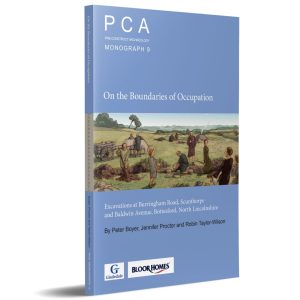Description
The area around Grange Farm has been dominated by a manorial centre since the medieval period and elements of this structure still stand. But as this monograph illustrates, by weaving together archaeological evidence and extensive research, a vivid, detailed picture has emerged of an enduring human presence at the site, from fleeting visits during early prehistory to a dramatic bombing of the landscape during the Second World War.
Occupation at Grange Farm began in earnest in the Late Iron Age, but the early post-conquest period saw increased activity in the area. The Roman road of Watling Street ran just 2km south of the site, while marshlands to the north were exploited as an important centre for the manufacture and distribution of salt and ceramics. Both clearly influenced the site’s development and by the early second century a holloway traversed the site, linking the two. By the fourth century major changes had been wrought. A new settlement layout incorporated an aisled building. Walled enclosures hint at the presence of orchards; ferrous metal-working and silver-refining were both practised. A stone mausoleum was built which held the remains of a woman in a lead-lined coffin; this was lifted to enable controlled excavation and detailed analysis off site. Excavations unearthed gold and jewelled necklaces, one of which is thought to have been an heirloom piece modified into a bracelet for a child.
Situated on an elevated terrace with far-reaching views, the mausoleum would have been visible for miles around and for many centuries as it stood, albeit in a ruinous state, into the 12th century. One of the earliest Scandinavian-style brooches known from England, a gilded silver example, may have been some form of votive offering focussed on this mausoleum and represents a particularly rare late-fifth-century find.







Neil Christie (University of Leicester) –
A few kilometres north of Watling Street and close to the Roman town of Rochester in N Kent, excavations by Pre-Construct Archaeology at Grange Farm identified intriguing Romano-British activity, adding to older reported finds in the zone (including an early 5th-century coin hoard): earlier/mid-imperial earthen agricultural enclosures giving way in the 4th century to (cob-)walled enclosures, plus roadway, aisled hall, smithy and, peculiarly, a mausoleum. The latter (of cruciform shape over a squared base of c 6.5 x 6.3 m) held still a lead coffin (pp 65–70) containing an elderly female (landowner/patron?), while fragmentary materials pointed to other (lost) burials here. Potentially the mausoleum and coffin saw (new/renewed?) veneration after farming and industrial activity here ceased: a late 5th-century gilded silver Nydam-style brooch is suggested as a votive offering (pp 70–2), as perhaps were two 5th-/6th-century spearheads (72–3); while apparent demolition of the enclosure walls was perhaps to make the mausoleum more visible around. While one Anglo-Saxon sherd came from the redeposited late-Roman midden spread covering the demolition deposits, no settlement (or burial) activity for the 6th to 11th century occurs. The last remnants of the mausoleum appear robbed out in the 12th century for reuse in a nearby manorial complex (not investigated in the 2003–06 excavated, but related ditches, pits and a well were revealed). An unstratified openwork copper-alloy cross-staff terminal, meanwhile, suggests a chapel hereabouts when Bishop Odo, brother of King William I, held Grange Farm (pp 74–5). Noteworthy was the strong recovery of coins and metalwork finds – including badges, tools, dress-fittings – of Roman to early-modern date (mostly unstratified) thanks to onsite metal-detecting. A nicely produced and well-illustrated monograph, this publication benefits from its detailed, balanced end-discussion (Chapter 4) which integrates all finds types analysed in the specialist reports in Chapter 3 (including pollen from the coffin and evidence for a tawny owl roosting in the mausoleum ruins).
NEIL CHRISTIE (University of Leicester)